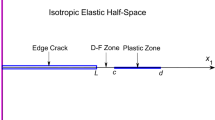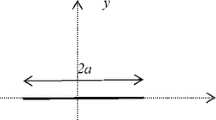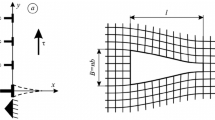Abstract
A dislocation model for simulating two-dimensional quasi-static crack propagation is presented. The crack and plastic flow along slip planes are described using dislocation dipoles. A stationary crack can be modeled as well as a propagating crack along a straight line inclined at an arbitrary angle to a free surface of a semi-infinite medium. Cracks are also allowed to kink. A superdipole algorithm is introduced to save simulation time without loosing important information and necessary geometric details. It reduces the number of dislocation dipoles on slip planes in the plastic wake. The paper gives results on crack shapes for stationary and advancing cracks as well as it describes how the size of the plastic zone depends on crack inclination angles. Results on stress intensity factors (SIF) are given using two different approaches as well as kinking cracks are introduced and SIF at kinked crack tips are calculated.
Similar content being viewed by others
References
Bilby BA, Cardew GE (1978) Stress intensity factors at the tips of kinked and forked cracks. The Fourth International Conference on fracture, University of Waterloo, Ontario, June 19–24, vol 3A, Pergamom Press, New York, pp 197–200
Bilby BA, Cottrell AH, Swinden KH (1963) The spread of plastic yield from a notch. Proc Roy Soc 272: 303–314
Bjerkèn C, Melin S (2003) A tool to model short crack fatigue growth using a discrete dislocation formulation. Int J Fatigue 25: 559–566
Cotterell B, Rice JR (1980) Slightly curved or kinked cracks. Int J Fract 16: 155–169
de Matos PFP, Nowell D (2006) Modelling fatigue crack closure using dislocation dipoles. In: Proceedings of 16th European conference of fracture, Alexandroupolis, Greece
Düber O, Künkler B, Krupp U, Christ H-J, Fritzen C-P (2006) Experimental characterization and two-dimensional simulation of short-crack propagation in an austenitic-ferritic duplex steel. Int J Fatigue 28: 983–992
Ewalds HL, Wanhill RJH (1986) Fracture mechanics. 3. Delftse Uitgevers Maatschappij, Delft
Hansson P, Melin S, Persson C (2008) Computationally efficient modeling of short fatigue crack growth using dislocation formulations. Eng Fract Mech 75: 3189–3205
Head AK (1953) Edge dislocations in homogeneous media. Proc Phys Soc B 66: 793–801
Hirsch PB, Roberts SG, Samuels J (1989) The brittle-ductile transition in silicon—II. Interpre Proc R Soc Lond A 421: 25–53
Lakshmanan V, Li JCM (1988) Edge Dislocations Emitted along Inclined Planes from a Mode I Crack. Mater Sci Eng A 104: 95–104
Melin S (1986) When does a crack grow under mode II conditions?. Int J Fract 30: 103–114
Melin S (1994) Accurate data for stress intensity factors at infinitesimal kinks. J Appl Mech 61: 467–470
Nowell D (1998) A boundary element model of plasticity-induced fatigue crack closure. Fatigue Fract Eng Mater Struct 21(7): 857–871
Pippan R, Riemelmoser FO, Weinhandl H, Kreuzer H (2002) Plasticity-induced crack closure under plane-strain conditions in the near-threshold regime, Philosophical Magazine A: Physics of Condensed Matter. Struct Defec Mech Proper 82(17-18): 3299–3309
Plank R, Kuhn G (1999) Fatigue crack propagation under non-proportional mixed mode loading. Eng Fract Mech 62: 203–229
Riemelmoser FO, Pippan R, Stüwe HP (1997) A comparison of a discrete dislocation model and a continuous description of cyclic crack tip plasticity. Int J Fract 85: 157–168
Riemelmoser RO, Pippan R, Stüwe HP (1998) An Argument for a cycle-by-cycle propagation of fatigue cracks at small stress intensity ranges. Acta Mater 46: 1793–1799
Riemelmoser FO, Gumbsch P, Pippan R (2000) Plastic deformation at short edge cracks under fatigue loading. Eng Fract Mech 66: 357–374
Riemelmoser FO, Gumbsch P, Pippan R (2001) Dislocation modelling of fatigue cracks: an overview. Mater Trans 42(1): 2–13
Riemelmoser FO, Pippan R (2002) Consideration of the mechanical behaviour of small fatigue cracks. Int J Fract 118: 251–270
Roberts SG, Noronha SJ, Wilkinson AJ, Hirsch PB (2002) Modelling the initiation of cleavage fracture of ferritic steels. Acta Materialia 50(5): 1229–1244
Schick A (2004) Ein neues Modell zur mechanismenorientierten Simulation der mikrostrukturbestimmten Kurzrissausbreitung, Fortschritt-Berichte VDI Reihe 18 (292)
Tanaka M, Tarleton E, Roberts SG (2008) The brittle-ductile transition in single-crystal iron. Acta Mater 56: 5123–5129
Wilkinson AJ, Hirsch PB, Roberts SG (1998) Modelling the threshold conditions for propagation of stage I fatigue cracks. Acta Mater 46: 379–390
Author information
Authors and Affiliations
Corresponding author
Rights and permissions
About this article
Cite this article
Stoll, A., Wilkinson, A.J. Dislocation modeling of quasi-static crack propagation in an elasto-plastic medium. Int J Fract 164, 103–115 (2010). https://doi.org/10.1007/s10704-010-9459-8
Received:
Accepted:
Published:
Issue Date:
DOI: https://doi.org/10.1007/s10704-010-9459-8




